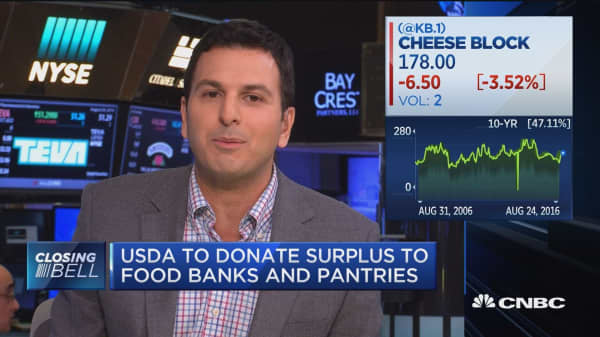This week, the US Department of Agriculture announced it would buy 11 million pounds of cheese for $20 million, after 61 congressmen and senators wrote a letter to the USDA asking for emergency help.
Why the sense of urgency? Dairy prices have dropped in the past two years, suffering from too much supply and not enough demand. That combination of supply going up and demand going down led to a textbook economics problem: Prices went down, a lot. Over 1,200 American dairy farms shut down last year, out of a total around 43,000.
Enter the federal government, with a $20 million buying spree using money that comes from a program called Section 32, which was passed as part of the Agriculture Act of 1935. The USDA sets aside a portion of import duties collected from customs receipts, using that money to buy agriculture products to stabilize prices. The food then goes to needy places like food banks and pantries, the school lunch program, international aid and even prisons.
CNBC contributor Ron Insana referred to the move as "quantitative cheesing." But if you're looking for prices to change on your next order of cheese pizza, don't expect much. Prices at the retail level take a lot longer to change, compared to futures markets where volatility is the norm.
"Dairy markets are inherently volatile," said John Newton of the American Farm Bureau Federation. "There's a lot of uncertainty and very high inventory levels. Reducing inventory levels could create an emotional response in the markets."
The seeds of the current crisis were sown two years ago, when high prices encouraged domestic farms to expand production, making investments in handling bigger capacity. In addition, the European Union removed milk production limits last year. Those two factors have only flooded the market with more supply, hurting prices.
That came at the same time international demand suffered, including a slowdown in China. Separately, Russia banned imports of Western dairy products as retaliation for sanctions put on it for invading Crimea.
Domestically, it's been a better story. Here in the U.S., cheese consumption is at record highs, averaging a robust 35 pounds per person.





